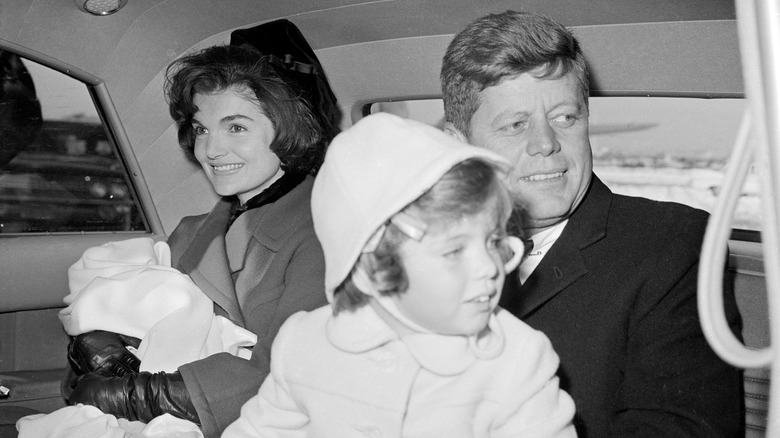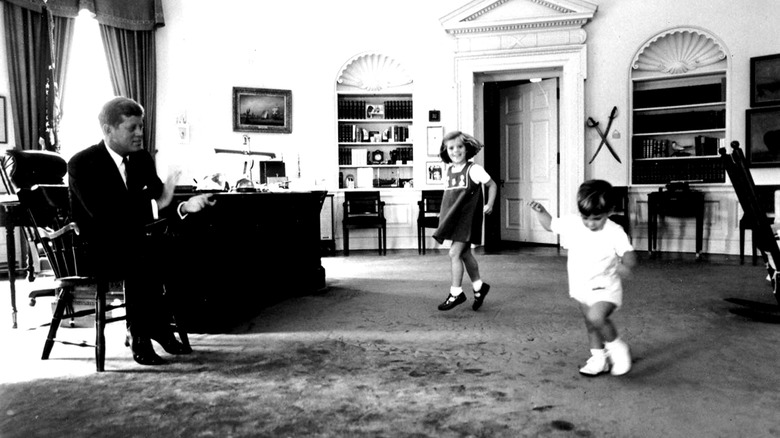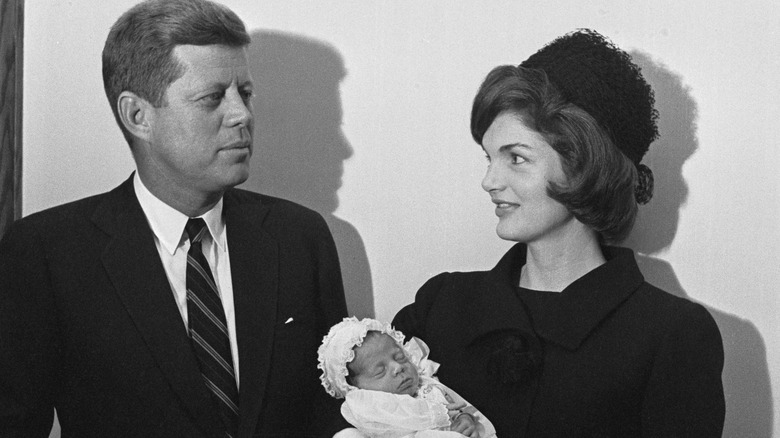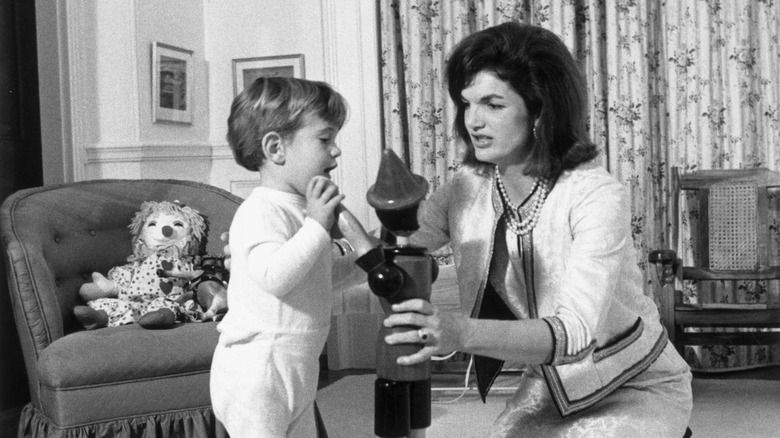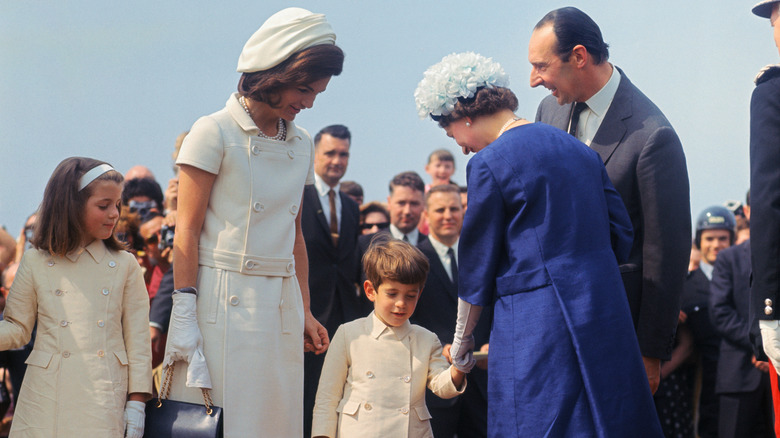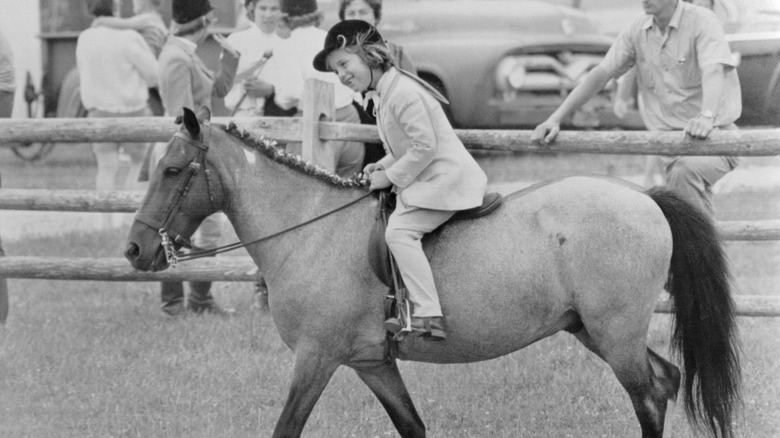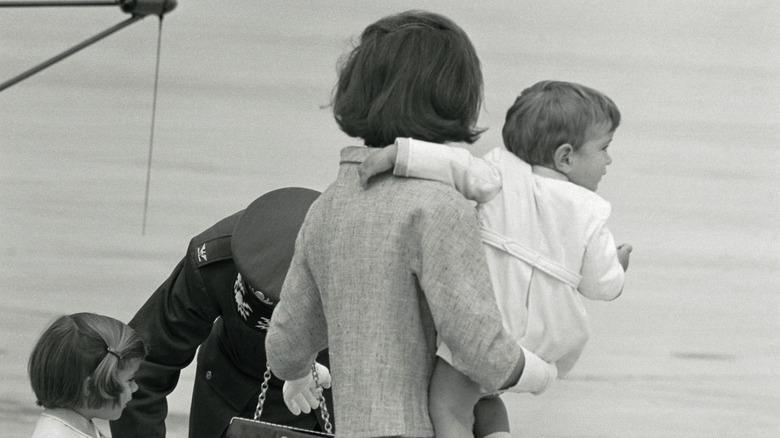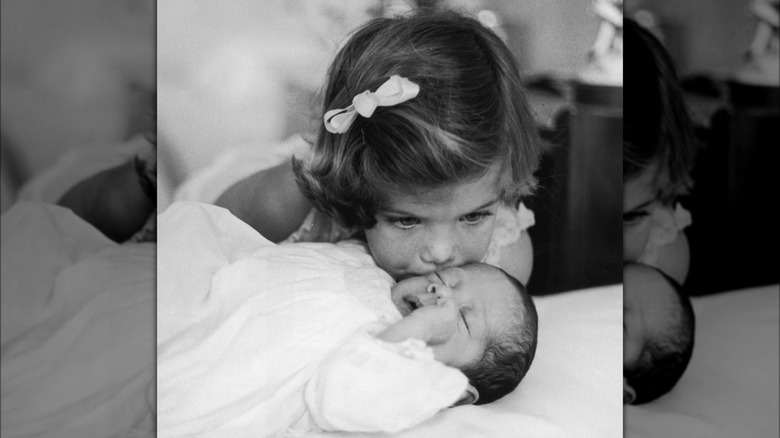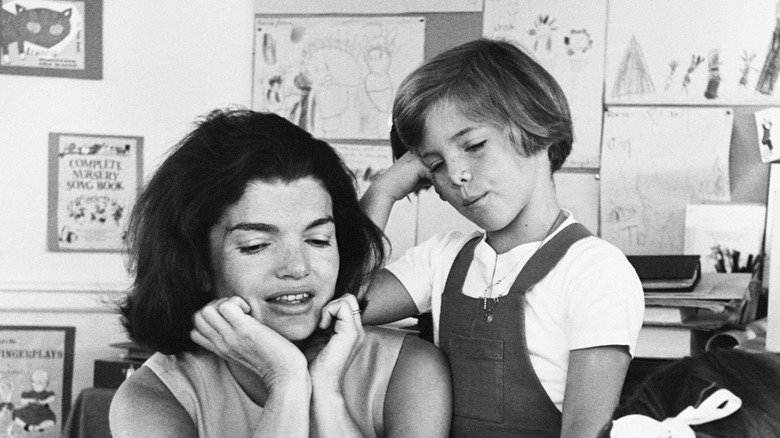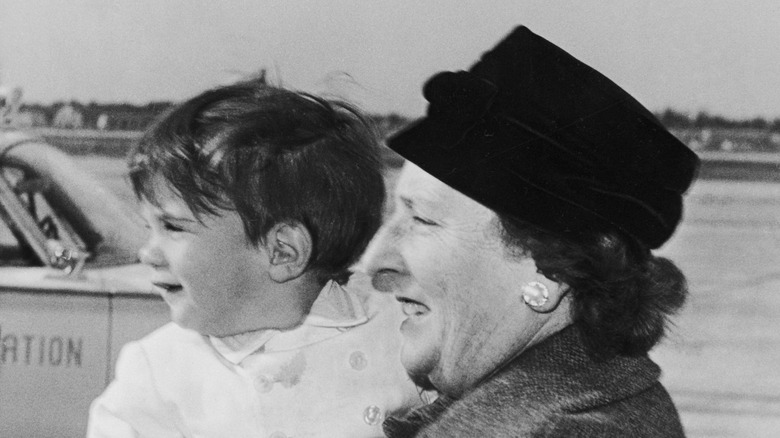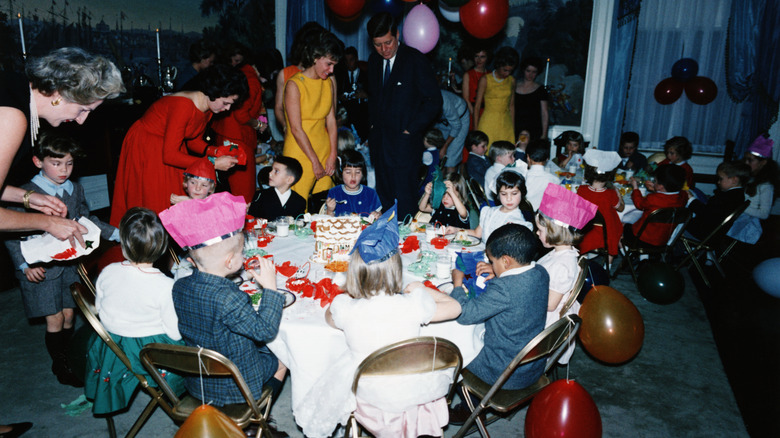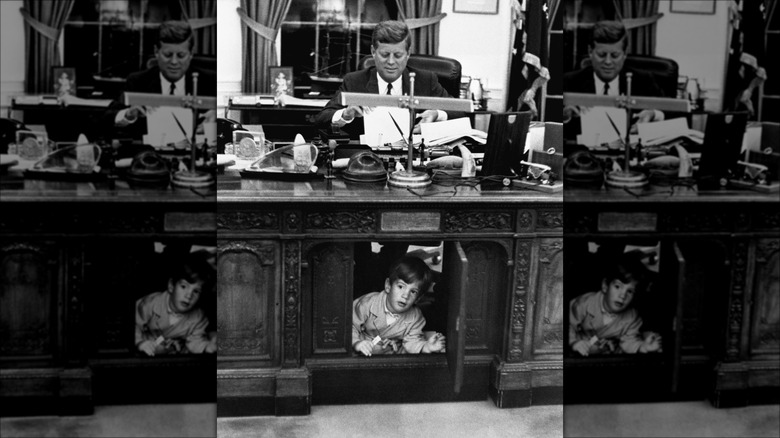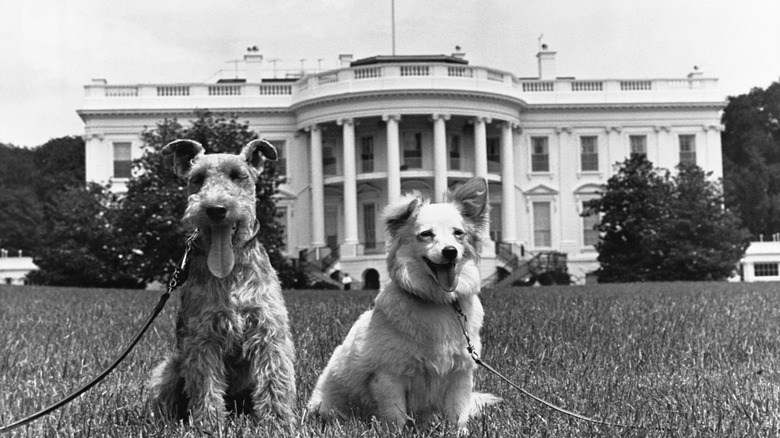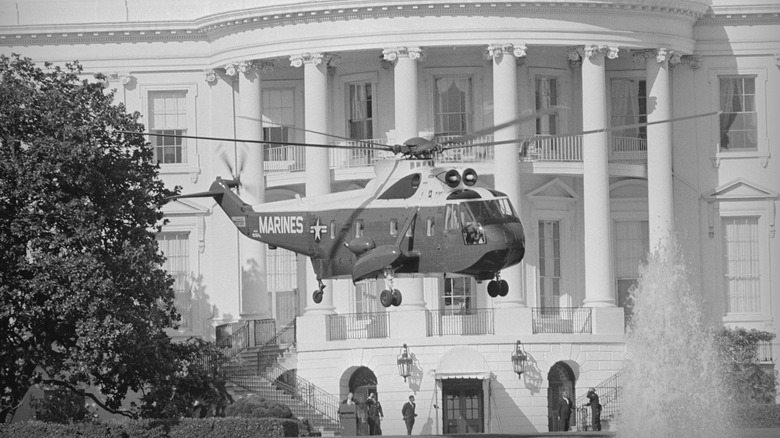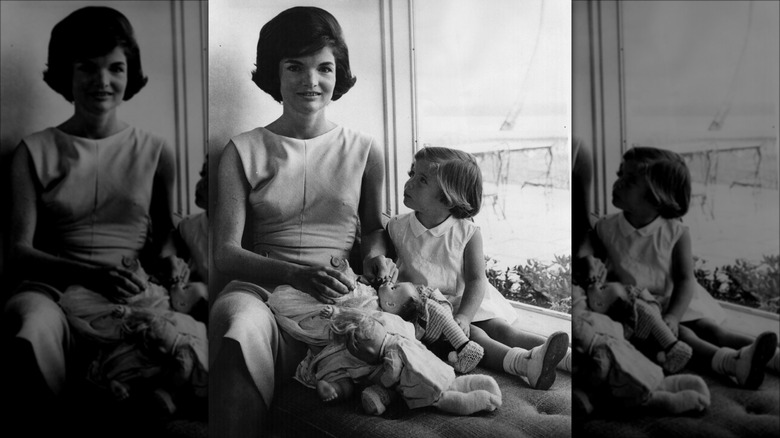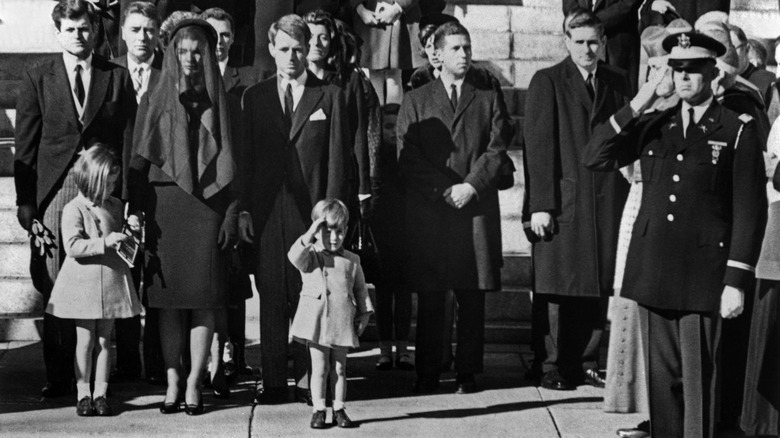What Caroline And JFK Jr.'s Lives Were Like In The White House
Many children have lived in the White House over the generations, but few have experienced the same sort of intense publicity and public trauma as the Kennedy children. Even before John F. Kennedy took office on January 20, 1961, his two children were subject to the fascinated attention of the press and members of the public. Caroline, the oldest, was not quite 3 when JFK was elected. The younger sibling, John Jr., was less than a month old at the time of his father's election and would spend the next few years growing into toddlerhood. Both siblings played throughout the White House, including in the Oval Office. But it all came to an abrupt, tragic end with their father's assassination in 1963.
Despite the sometimes overwhelming flood of media attention, it can be difficult to get an understanding of what it was really like to be a young child in the White House during the Kennedy administration. For all that photographers and news reporters tried to get a peek into the family life of the Kennedys, people like mother Jackie were understandably tight-lipped. That's all the more complicated when you take in the fact that both Caroline and John Jr. were living during the Cold War, ongoing debates about desegregation, and the traditions of both the White House and international diplomacy. Drawing on historical accounts and eyewitness testimony, their childhood experiences were both typical and marked the blessings and problems of being the president's kids.
Staff said the young children brightened up the home
To many of its inhabitants, the White House must seem to be seriously weighed down by history. The current building, stuffed as it is with paintings, antiques, and other valuable objects, was first inhabited in 1817 (an earlier structure on the site was burned down by British forces in the War of 1812). With all those decades of occupation and intense situations, some have found the atmosphere inside to be downright stultifying.
Perhaps that's why multiple people have described the arrival of a toddler Caroline and infant John Jr. as a breath of fresh air. As retired staff member Bill Hamilton told Inside Edition, "It was just so nice to see. You didn't think this would ever happen in the White House." Surely, the sight of Caroline riding her pony around the property must have contrasted with the relatively child-free White House Hamilton first encountered when he started working there as part of the Eisenhower administration.
Meanwhile, former Secret Service agent Clint Hill told People that he fondly remembered the growing John-John, as the young boy was sometimes called, as a considerably energetic presence throughout the White House. On a broader scale, quite a few people saw the appearance of a young first family, complete with Jackie cradling an infant John Jr. and a toddler Caroline playing in the historic mansion, as a way to popularize President Kennedy and bring an oftentimes distant figure all the closer to the masses.
John Jr. entered the White House as an infant
Though much was made of the arrival of the Kennedy children in the White House, the children themselves didn't necessarily have the strongest memories of their arrival there. Caroline Kennedy, who was 3 when her father became president, was at least cognizant of the occasion. Arriving at the White House for the first time in a presidential limo flanked by the press, Caroline reportedly exclaimed of the structure, "It's so big. It looks like a castle" (via "American Legacy: The Story of John and Caroline Kennedy," by C. David Heymann).
Her little brother, John-John, offered no such comment, given that he was only two months old at the time and likely asleep in the same limo in his bassinet. Yet, despite his very young age, he was already the subject of great public interest. Even before moving into the White House, a swaddled newborn John Kennedy Jr. had already been publicized in a newsreel, carried by his nanny into a car as his president-elect father and mother followed behind. It's understandable why the press and public were so interested, as young John would be the first infant in the White House in many decades. That last happened on September 9, 1893, when first lady Frances Cleveland gave birth to her daughter, Esther, in the White House.
Onlookers reported that Jackie Kennedy was especially close to her children
First lady Jackie Kennedy is remembered as an especially involved mother. Multiple onlookers, historians, and writers have noted that she was often with her children, engaging with the sort of on-the-ground work of parenting that often requires reading books multiple times and getting messy with a young child's art project. She was also seen checking her children's homework and, as any parent of a young child sometimes must do, disciplining unruly toddlers. As she told a reporter on the cusp of her family's time in the White House, "If you bungle raising your children, I don't think whatever else you do matters very much" (via Britannica).
However, it's not as if Jackie Kennedy was a harried suburban mother balancing housewife duties with the demands of raising two young children. For one, she was expected to take part in the public relations side of her husband's presidency, including heading up a historically minded redesign of the White House interiors and presenting the results to wide interest on television in 1962. She also had the resources of a well-off family and the White House at her disposal, meaning that a nanny and other staff members helped to care for the children. Still, it was clear that she was very much a part of her children's lives, issuing orders to the nannies and other staffers as someone who had the final word much of the time.
Juggling normalcy with White House privileges
As both parents expected, raising two young children in the White House proved to be a complicated balancing act between striving for a sense of a regular family life and admitting the fact that they were all on a massive stage. Jackie Kennedy was keenly aware of this, taking advantage of the unique situations and opportunities presented to Caroline and John-John but also wanting to give them some sense of normalcy. As former Secret Service agent Clint Hill told People, "She gave us implicit instructions that they should be permitted the opportunity to grow up as normal children as humanly possible. And I always kept saying, 'They're the children of a president of the United States, it's never going to be like other children throughout their entire life.'"
That normalcy included visits to the park for the children, although accompanied by a nanny (and presumably a Secret Service agent or two). Both also went on playdates at other homes and, in what may have been a memorable occasion for others, invited friends to the White House for the same. Staff members were also instructed to allow Caroline and John Jr. to independently figure out their problems, even if that meant allowing the president's young children to get up from their own tumbles once in a while.
Still, both parents had to accept that both children would be in exceptional situations. How many toddlers have to be taught how to bow to royalty, after all?
Both parents were cautious about press attention
As memos written in her own hand make very clear, Jackie Kennedy could get rather prickly about the press attention that so often focused on her children, even before the Kennedy family had moved into the White House. As time went on, she asked staff to undertake the largely impossible task of keeping both children out of the press. Both parents eventually stated that certain things were off-limits, like taking unsanctioned pictures of Caroline or John Jr. while they were playing in the fenced areas of the White House lawn. Jackie even occasionally raised the specter of a lawsuit against publications or members of the press, especially when reports made erroneous claims. But it was all too clear that she was often better off leaving things alone beyond a certain point, including suing troublesome publications. After all, they were a newly accessible first family that inevitably drew attention from seemingly all quarters.
Caroline, however, proved to be a sort of potential public relations hurdle when members of the press came around. On the odd occasion that she spoke directly to a reporter, she could be charmingly (if also frustratingly) unfiltered. As she once told a reporter for the St. Louis Post-Dispatch who asked where her father was, Caroline replied, "He's upstairs with his shoes and socks off, doing nothing." As for Jackie: "She 's upstairs in her bathrobe, also doing nothing" (via "American Legacy").
The childrens' safety was a common concern
As part of the security issues she saw around her children, Jackie Kennedy often requested that she be the first to hear about permissions given to the press, even if her husband had already given the go-ahead. To her, this should also include articles set to be published, as one Newsweek piece featuring a young Caroline Kennedy at ballet lessons had unnerved her enough to cancel her daughter's attendance. It was with this caution in mind that she would establish a kind of private school in the White House. To Jackie's mind, it would give her daughter a more normal experience, compared to sending Caroline off to a less-controlled classroom with armed guards.
These concerns shouldn't be dismissed as the anxieties of overworked parents, either. Sometimes, the threat was all too close to home. In 1961, while on vacation, the Kennedys received a kidnapping threat focused on the children. Though the note was anonymous, it appeared to have come from pro-Castro communists in Cuba, who said they would take both Caroline and John Jr. as insurance against an attack on Cuba. The Kennedy children were flown back to Washington, D.C., Secret Service protection for the family was increased, and Jackie learned of a U.S.-backed plot to overthrow Castro, known as Operation Zebra. It's clear that Caroline and John Jr. were faced with very real threats that certainly weren't well-known to most other American families.
The siblings were fairly close
Given that they were barely three years apart and growing up in the rarefied world of the White House, it's not shocking to learn that a young Caroline and John Kennedy Jr. were close. As the elder sibling, Caroline was known to often read to John Jr., though the 1-year-old brother was sometimes more interested in causing chaos than sitting quietly. She also tended to remember her brother when gifts came around, whether that was requesting an extra sticker for him or delivering a lengthy Christmas toy list for him to a White House telephone operator playing the part of Mrs. Claus.
As happens with so many sibling relationships, however, things grew complicated as the two aged. Friends and family reported that John and Caroline still loved each other, but John prickled at Caroline's reportedly snotty friends and ways, clearly anxious that he was perceived as a wayward young man who wasn't quite measuring up to the rest of his famous, accomplished family. The regimented, brainy Caroline, for her part, seemed to be worried that the relaxed John Jr. really wasn't living up to his potential. "Can't he keep his shirt on?" she reportedly said on one occasion (via "America's Reluctant Prince: The Life of John F. Kennedy Jr.," by Steven M. Gillon). Still, though some frostiness had made its way into the siblings' relationship, they remained ultimately committed to loving and supporting one another at the time of John Jr.'s sudden death in a 1999 plane crash.
Both went to school in the White House
Though the Kennedys attempted to create a sense of normalcy for their two children during JFK's term, they ultimately had to admit that the situation called for some alternative education. At first, that was a play group organized by Jackie Kennedy for Caroline, which then morphed into a preschool that included children of White House staff and Kennedy family and friends. Though he would have been too young for most of the curriculum, John Jr. also eventually joined the playgroup.
The program was funded by parent contributions, which paid for two teachers and supplies up through the first grade. With classes in the White House solarium, the students also enjoyed a playground on the South Lawn while wearing red, white, and blue clothes according to a dress code that had been selected by the first lady. Even before the Kennedys arrived, the solarium had long been in use as a kid-friendly playroom for family members like FDR's and Dwight D. Eisenhower's grandchildren. For Caroline and her classmates, it became the space where they took lessons in math, history, grammar, and French, among other subjects.
The two had an almost stereotypical English nanny
As much as Jackie Kennedy spent time with her children — and she really did, from family vacations to visiting their classroom in the White House — she didn't do it alone. For the day-to-day care of Caroline and John Jr., there was English nanny Maud Shaw. Starting in 1957, less than two weeks before Caroline's birth, Shaw worked with the Kennedy family until her retirement in 1965. She was a major factor in the well-ordered life of both children, though Shaw later told The Daily Times-News in 1966 that the more outgoing John Jr. didn't always play by her established rules and tended to be far more extroverted than the routine-loving Caroline.
Despite the personality differences, Shaw was a constant in both of the children's lives, from giving a late night (or early morning) bottle to the infant John-John to showing Caroline and her brother how to curtsy or bow to foreign dignitaries. She sometimes even drew comparisons to Mary Poppins.
While in the White House, Shaw lived on the second floor of the mansion, between Caroline and John Jr.'s rooms. Jackie reportedly told household manager J.B. West that all Shaw needed was a small trash can and a table on which to place her dentures, though one hopes that Shaw got a bit more compensation than that for all those midnight bottles, off-the-cuff etiquette lessons, and the patience required to discipline and redirect two young children.
Caroline Kennedy's kindergarten was integrated
While campaigning for the presidency, one of JFK's promises was that he would seek greater progress in civil rights for Black Americans. Though civil rights laws had already been in effect for years, such as the landmark 1954 Brown v. Board of Education Supreme Court decision that effectively called for the desegregation of schools across the nation, those laws met with resistance and were sometimes difficult to enforce.
Once in office, however, Kennedy often faced criticism for seeming reluctant to get the job done, though he did work to introduce the Civil Rights Act of 1964 in Congress (it would not pass until well after his November 1963 assassination). Early on in the Kennedy administration, however, there was at least one relatively small show of support for equal rights in Caroline's kindergarten classroom.
Apart from the Kennedy children, the only other student in the White House school who was identified was Avery Hatcher, the 5-year-old son of associate press secretary Andrew Hatcher. The young boy came to public attention after he joined Caroline's kindergarten class. Avery, whose father was the first Black associate press secretary to work with a U.S. president, was quietly put forth as proof that Caroline's class was integrated in line with her father's campaign promises to push for better integration of schools throughout the nation.
Both children were often welcome in the Oval Office
In keeping with the family atmosphere of the home, both John-John and Caroline Kennedy could sometimes be found with their father. Most famously, a toddler John Jr. was photographed playing beneath the office's famed Resolute Desk while his father sat above. White House photographers also snapped a picture of Caroline playing under the same desk. Caroline was also in the habit of spending time with her father while he ate breakfast, then walking with him to the Oval Office, a sort of family tradition that John-John later joined as well.
An increasingly ambulatory John Jr. was known to stroll — or run — into the office and even interrupt meetings. Staff members could be downright indulgent on this front, to the point where John-John played hide and seek with Secretary of State Dean Rusk. Beyond the White House, John Jr. even got to have lunch with the Attorney General and have a private tour of the F.B.I. building. Perhaps access was made easier by the fact that the A.G. was his uncle, Robert Kennedy.
Other kids were known to spend time around the president, as Caroline's kindergarten and first-grade classes occasionally came in from their South Lawn playground while JFK was taking a break. They also produced drawings of the adults around them, including the president, whom many must have known as more of a familiar grownup than a statesman.
Caroline Kennedy had a menagerie of pets
Just a couple of years into JFK's presidency, Caroline Kennedy and the rest of the family had amassed quite a collection of pets. One of the most famous was Macaroni, a pony reportedly given to Caroline by Vice President Lyndon Johnson, though other sources indicate that Johnson actually gave her a different pony named Tex, or that Caroline even named the pony John Jr. The human John Jr. eventually had to manage an allergy to horses and was never quite as fond of his own pony, Leprechaun (a gift from the people of Ireland).
The most politically consequential pet was likely Pushinka, a small mixed-breed pup. Pushinka's mother was Strelka, a dog who had survived a Soviet space mission. According to Jackie Kennedy, she had been seated next to Soviet premier Nikita Khrushchev at a dinner, where she inquired about Strelka and her puppies. Months later, one of those puppies was sent to the White House, to the surprise of JFK. Pushinka had puppies again with another Kennedy dog, a Welsh terrier named Charlie.
Other animals in the White House included other dogs, a cat named Tom Kitten, the hamster duo Debbie and Billie, a rabbit that went by Zsa Zsa, and a variety of birds that even included a flock of white ducks. Even with staff looking after the animals, it all got to be a bit much. The White House eventually had to institute a ban on pets sent to the family.
John Kennedy Jr. was fascinated by the presidential helicopter
As John-John grew older, it became clear that the young boy was utterly engrossed by aircraft. Lucky thing, then, that he so often got to see planes and helicopters and even ride in them regularly, including the helicopters that occasionally landed on the White House lawn. Unlike many other youngsters, he also was able to interact with military personnel who had access to aircraft, like White House Air Force aide Godfrey McHugh. McHugh met the younger John Kennedy when the boy interrupted a meeting with the president while wielding a toy helicopter. Even when John was older and had moved out of the White House, McHugh kept in touch. He arranged for a decommissioned World War II-era plane to be delivered to the Kennedy household, where a school-age John enthusiastically played behind the controls of the immobile craft for hours. While in the White House, McHugh also helped contribute to John's growing collection of aircraft models.
More broadly, the young John was interested in all sorts of military subjects — again, it was surely pretty handy to have one's father as the commander-in-chief in these circumstances. Speaking to People, former Secret Service agent Clint Hill recalled the boy going into the woods around a different property and playacting at being a soldier, with a nanny going along and pretending to be his military nurse.
Caroline Kennedy gathered a serious doll collection
Caroline Kennedy also amassed a staggering array of dolls from 1961 to 1963, oftentimes given to her by heads of state and other foreign dignitaries. Many of the toys represented their countries and cultures of origin, such as sari-clad dolls given by Indian Prime Minister Indira Gandhi or another clad in colorful prints courtesy of Ivory Coast President Felix Houphouet-Boigny. Jacqueline de Gaulle, the wife of French President Charles de Gaulle, gave Caroline a massive 5-foot-tall playhouse inscribed with the girl's name (it was later a plaything used by Caroline's own children).
When it came to managing the many, many dolls sent to Caroline, some of the especially nice ones — like an array of elaborate hina dolls sent from Japan — were set aside, while others appear to have gone into rotation as everyday playthings or were eventually sent to the collections of the John F. Kennedy Presidential Library and Museum. Some of the dolls were put into service as educational tools, as the nation-specific toys were linked to a map of the world in Caroline's geography lessons.
Both children even became dolls. The likenesses of Caroline and John Jr. were reproduced in doll form by high-end dollmaker Deewes Cochran. It's not clear if either of the Kennedy children experienced the existential crises of playing with doll versions of themselves, though the pair was given to the Kennedys by a member of the public (and donated to the JFK Library in 1965).
The children's nanny told them of the assassination
The children's time in the White House ended with undeniable tragedy. On November 22, 1963, both of their parents were in Dallas, Texas, unofficially campaigning for John F. Kennedy's reelection. When their motorcade entered Dealey Plaza at midday, the president was abruptly shot and killed.
Telling the president's children was an especially awful task that ultimately fell to their nanny, Maud Shaw. Jackie Kennedy's mother, Janet Auchincloss, asked Shaw to break it to the children. As Shaw later wrote in her memoir, "White House Nannie," she managed to get the children through their bedtime routine despite the mounting dread. With John Jr. asleep, she started to read to Caroline but could not stop crying. When the young girl asked what was wrong, Shaw said, "I can't help crying Caroline, because I have some very sad news to tell you." After an intense round of crying, Caroline eventually fell asleep, and Shaw stayed up for hours.
Jackie was reportedly upset that the children didn't hear of their father's death directly from their mother. Perhaps that's why there were reports of a growing iciness between mother and nanny, to the point where Shaw was abruptly told she would no longer be needed after the family traveled to England in 1965. When Shaw published her memoir the next year, Jackie was reportedly upset at what she believed to be a serious breach of privacy, though Shaw's recollections were more than favorable to the family.
